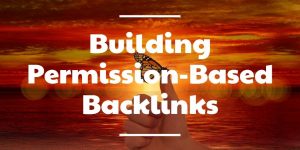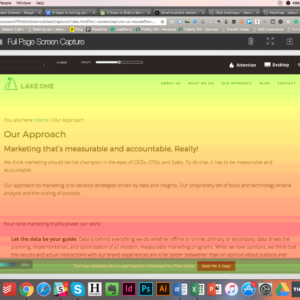Whether you’re an experienced marketer or just getting started, guest blogging is a great way to build an organic presence on the web.
Getting your article published on big-names like Hubspot or Forbes is bound to get you some quality traffic back to your website. If your blog is optimized for lead generation, you can convert these visitors into prospects and potential customers.
Before you start writing for prominent websites in your niche, you’ll want to make sure that it’s worth your time and effort. Any guest blogging opportunity should benefit both the writer and website owner. It’s your duty to create valuable content for their readers. In return, they should provide quality backlinks and traffic to one of your personal web properties.
Below are 7 tips you can use to maximize your conversion rates with guest blogging.
1 – Create a Captivating “Boilerplate”
If you create and write valuable content, people will gravitate toward the host’s site by way of organic search and word of mouth; however, that doesn’t always mean they’ll take the time to research your brand on their own time.
One way you can encourage readers to visit your website is by writing an awesome boilerplate.
A boilerplate is a short, 3 to 4 sentence biography that should address the following:
- Who are you?
- What do you do?
- Who do you help?
- What’s the explicit call to action?
Let’s assume that you are writing for an authority website like BusinessInsider. Here is an example of a boilerplate that you can use to entice readers to go back to your website:
“This is a guest article by Your Name, lead marketing expert at YourWebsite.com. Your Name specializes in Facebook marketing strategies for small eCommerce businesses. Grab his/her free report on the ‘Top 10 Facebook Tips For Beginners’ today.”
Notice that everything is geared towards the audience’s needs. In addition, a free course is offered (i.e. the call to action) that will help potential buyers with a specific problem.
2 – Create a Landing Page Specifically for the Audience
If you send traffic directly to your blog from the guest site, you are missing out on a plethora of qualified leads.
If you want to build your email list through guest blogging, create a high converting landing page that addresses the theme of the website for which you’re writing.
Landing pages should narrow the focus of your visitor and limit potential distractions. It should include short, succinct language that entices them to take action.
Furthermore, your landing page should have a similar feel to the article you wrote. If you wrote an article about email marketing, your offer should be centered on that particular topic. You could create a free report that educates your prospects about autoresponders, broadcast messaging, or email segmentation. The body copy of the landing page should outline the immediate benefits to the customer.
Your specific area of expertise might vary from some of the websites for which you guest post, and it’s clear you should refrain from guest posting on sites that have absolutely no relevance to your niche. But as long as you lead with value in relation to the specific audience’s goals (find this out by doing some research, which can include asking the site owner or editor), you won’t have a problem generating new opt-ins and backlinks to your website.
3 – Write a Captivating Headline
No matter how good your offer, visitors will leave your landing page if the headline doesn’t leave them wondering about or wanting to know more about your product or service. In fact, the headline is arguably the single most important factor in any type of marketing advertisement.
When linking to your landing page from a guest blog, make sure you have headlines that will capture the attention of their audience. One of the best resources I’ve found for writing headlines is the “10 Commandment” approach. Here’s a handful of tips that you can use to optimize your headlines:
- Big and bold, at least 50% larger than the text in your body copy
- Make it unique and phrase your offer in a way that separates your product/service from others on the web
- Speak directly to the core desires and interests of your prospects
- Be specific (will it help men lose 20 pounds of fat in three weeks? Does it only take 7 minutes to complete? Will it increase ROI by 32%?)
- Avoid using your brand name; use language that reflects direct benefits to the audience
4 – Write Killer Body Copy
Once you’ve garnered the attention of your prospect with a great headline, you’ll need strong body copy to engage and convert them. More often than not, you should use clear and concise language that highlights the unique aspects of your offer.
Avoid using words like “I” and “we” and instead focus your attention on the prospect. Body copy should identify the obstacles or issues that prospects are looking to address, and this language should tie into the call to action. Refrain from using arbitrary phrases such as, “Sign Me Up.” Instead, use benefit driven language that entices your prospects to opt-in. An example of a good call-to-action would be, “Yes, Send Me My Video Now.”
Your offer should be presented as the solution to their problem. If you have successfully hooked them in your body copy, they will often take the next step without hesitation.
5 – Include an Image on the Landing Page
Whether you’re giving away a digital or physical product, you want to provide a visual representation of your offer. The human brain likes visuals, and the right image will increase the perceived value of your content and eliminate ambiguity on your landing page. Making your offer more obvious with visual mediums is almost guaranteed to increase your opt-in conversion rates.
6 – Put A Direct Call To Action In The Button Copy
High converting landing pages will include an explicit call to action in the body copy. For optimal results, your call to action and headline should be positioned “above the fold” of your landing page. Another strategy is placing your call to action in the copy of your button (i.e. replace a button that reads “Submit” with one that says “Get FREE Guidebook Now!”) Direct, yes; but your audience will get the idea fast and be able to “take action” by pressing that button.
7 – Test, Test, Test!
If you want to maximize lead conversions, you’ll need to test your landing pages to better understand the needs and desires of your potential customers.
There are a variety of ways to test landing pages, but a few best-practice strategies include:
- Create several headlines that emphasize different benefits and implement A/B testing to determine the best converting headline.
- Rotate different calls to action on your button copy. You’ll be surprised on how much of a difference a few words can make!
- Test different images of yourself, your brand, and your offer.
- Try putting a short but educational video on your landing page.
- Though design is not everyone’s strong suit, color matters. Test varying color contrasts in your headlines, body copy, images, and buttons and see what attracts.
In truth, every aspect of your marketing should be tested for success. Winning landing-page elements can be incorporated into your sales pages, emails, and social media campaigns. The more you test, the better your overall marketing campaigns long term.
Closing Thoughts
Whether guest blogging or writing your own articles, remember that you should always direct your visitors to a landing page, a launching pad for building profitable email autoresponder campaigns and converting more leads into recurring customers.
What other guest blogging strategies do you use to build your email list?
Digital & Social Articles on Business 2 Community(20)






